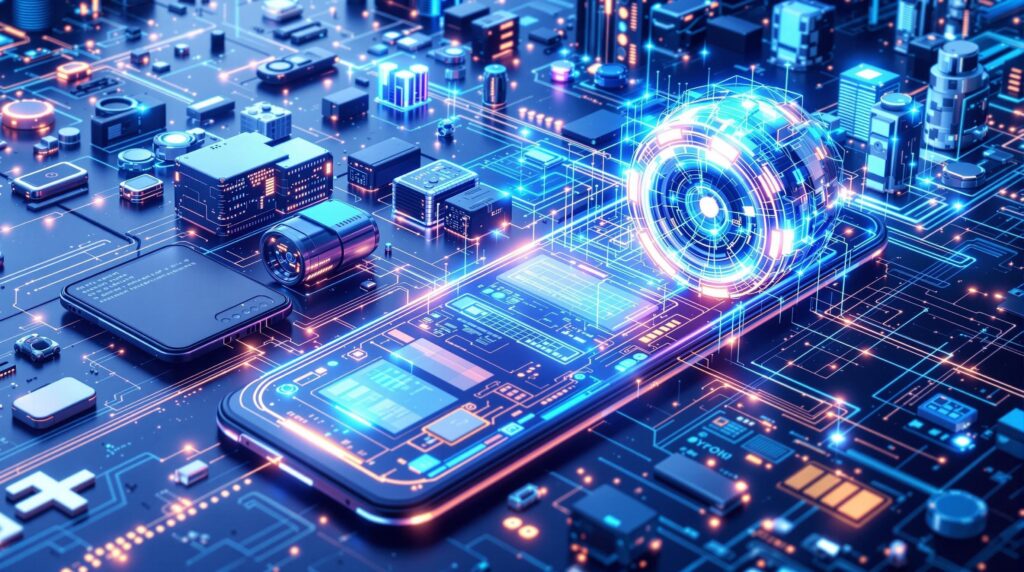The tech landscape is rapidly evolving with groundbreaking innovations that are fundamentally changing how we interact with our devices. From flexible displays that fold like paper to neural interfaces that can interpret brain signals, these futuristic gadgets are not just enhancing our smartphones and computers but revolutionizing their very essence.
Key Takeaways
- Foldable display technology has matured beyond experimental stages to become mainstream in premium devices
- Neural interface gadgets are bridging the gap between human thought and digital interaction
- Self-healing materials could potentially eliminate the need for screen protectors and cases
- Quantum computing components are beginning to appear in consumer devices for specific applications
- Augmented reality glasses will soon replace traditional smartphone interfaces for many daily tasks
https://www.youtube.com/watch?v=KFsddFc-sI4
The Evolution of Display Technology
Display technology has made remarkable strides in recent years, with flexible OLED panels leading the charge. Unlike traditional rigid screens, these displays can bend, fold, and even roll without damaging the pixels. This flexibility has enabled manufacturers to create devices that transform from compact smartphones to tablet-sized screens with a simple unfolding motion.
The latest generation of foldable displays has addressed many of the durability concerns that plagued early models. New polymer materials now allow for over 200,000 fold cycles without visible creasing, effectively solving one of the biggest challenges in this tech category. Additionally, these displays now offer refresh rates up to 120Hz even in their flexible form, ensuring smooth animations and responsive touch interfaces.

Neural Interfaces: Controlling Devices With Your Mind
Perhaps the most sci-fi-like advancement in recent tech innovations is the development of consumer-grade neural interface devices. These gadgets can detect electrical signals from your brain and translate them into commands for your digital devices. The technology has advanced from bulky, medical-grade equipment to sleek wearables that resemble ordinary headbands or earbuds.
Early applications focus on simple commands and inputs, such as mentally selecting options on a menu or scrolling through content without touching the screen. For users with mobility limitations, these interfaces offer revolutionary accessibility options, potentially making digital technology more inclusive than ever before. As neural interfaces become more sophisticated, they could eventually replace traditional input methods like keyboards and touchscreens for many applications.
The integration of these interfaces with automated digital systems is creating entirely new ways to interact with our devices, making technology feel more like a natural extension of ourselves.
Self-Healing Materials for Durable Devices
One of the most frustrating aspects of modern smartphones is their vulnerability to scratches, cracks, and other physical damage. New self-healing materials are set to change this reality. These polymers contain microcapsules filled with repair agents that automatically flow to damaged areas when the surface is compromised.
The first generation of self-healing screens can repair minor scratches within hours, while more serious damage might take up to 24 hours to heal completely. This technology extends beyond just screens – phone bodies and even internal components are being developed with similar self-repair capabilities.
For consumers who frequently deal with screen damage issues, these materials could significantly extend device lifespan and reduce repair costs. The environmental impact is equally important, as longer-lasting devices mean fewer electronics entering the waste stream.
Quantum Computing Components in Consumer Devices
While full quantum computers remain largely confined to research labs, specific quantum computing elements are beginning to appear in high-end consumer devices. These components don’t replace traditional processors but complement them for specialized tasks where quantum advantages are clear, such as cryptography and certain types of pattern recognition.
The first implementations focus on security applications, with quantum-resistant encryption becoming increasingly important as conventional encryption faces threats from advancing computing power. Some premium smartphones now include dedicated quantum security chips that generate truly random encryption keys based on quantum principles.
Beyond security, these quantum components accelerate specific AI functions, allowing for more sophisticated processing of images, voice, and other complex data right on the device without needing to send information to cloud servers. This improves both privacy and speed for the end user.
Augmented Reality Glasses: The New Interface
Smartphone screens may soon be supplemented or even replaced by augmented reality glasses that project digital information directly into your field of view. Unlike previous bulky AR headsets, the newest generation resembles ordinary eyeglasses while containing sophisticated projection systems, cameras, and sensors.
These glasses allow users to see notifications, navigation directions, and other digital content overlaid on the physical world. For tasks that currently require looking down at a phone screen, such as checking messages or following maps, AR glasses provide a more natural and less disruptive experience.
The integration with streaming services is particularly impressive, allowing users to project virtual screens of any size into their environment for watching videos or playing games without the constraints of physical display dimensions.
Holographic Projection Systems
Moving beyond flat screens altogether, holographic projection systems can now create three-dimensional images in mid-air without requiring special glasses or headsets. These systems use precisely controlled light beams to create the illusion of physical objects floating in space.
Early consumer versions can project images up to 15 inches in size within a limited viewing angle. While not yet suitable for replacing primary displays, they excel at showing 3D content like product models, architectural designs, or interactive maps that benefit from being viewed from multiple angles.
The technology works by creating tens of thousands of light points per second, synchronized precisely to create coherent images. As computing power increases and the systems become more compact, we’ll likely see holographic capabilities integrated directly into smartphones and laptops rather than existing as separate accessories.
Battery Technology Breakthroughs
Power limitations have long constrained what’s possible with portable tech, but new battery technologies are finally addressing this challenge. Solid-state batteries replacing liquid electrolytes with solid materials are entering the market, offering higher energy density, faster charging, and improved safety compared to traditional lithium-ion batteries.
The first generation of solid-state batteries in consumer devices can charge to 80% capacity in under 10 minutes while holding up to 40% more energy than same-sized conventional batteries. Perhaps most importantly, they degrade much more slowly, potentially doubling or even tripling the effective lifespan of device batteries.
Complementing these advanced batteries are new energy-harvesting systems that can continuously generate small amounts of power from ambient sources like light, heat, and movement. While not enough to fully power a device, they can significantly extend battery life by trickle-charging throughout the day.
Modular Computing Ecosystems
The distinction between different computing devices is blurring with the rise of modular computing ecosystems. These systems allow core computing components to be shared across different form factors, effectively turning your smartphone into your laptop, desktop, or even your smart TV’s computing brain when needed.
Advanced connection protocols enable near-instantaneous transfer of computing contexts between devices, so you can begin working on your phone and seamlessly continue on a larger screen without interruption. The underlying hardware architecture has been redesigned to prioritize this kind of flexibility rather than treating it as an afterthought.
For consumers, this means potentially significant cost savings as they need to purchase and upgrade fewer separate devices. It also creates a more consistent experience across different computing contexts, as your preferences, files, and computational capabilities follow you between devices.
Advanced Biometric Security
Passwords and even current biometric methods like fingerprint scanners are giving way to more sophisticated authentication systems. These new systems combine multiple biometric factors simultaneously, making them both more secure and more convenient.
Continuous authentication systems now monitor patterns in how you hold your device, your typing rhythm, your gait when walking with the device, and even your heartbeat pattern via sensors built into device bodies. Rather than authenticating once when you unlock your device, these systems continually verify your identity in the background.
If the system detects anomalies suggesting someone else might be using your device, it can dynamically adjust access permissions or require additional verification. This creates a security model that’s simultaneously more secure against unauthorized access while being less intrusive for legitimate users.
AI-Optimized Hardware Architecture
Traditional computing architectures designed primarily for general-purpose processing are being supplemented by specialized hardware optimized specifically for artificial intelligence workloads. These neural processing units (NPUs) can perform machine learning tasks with far greater efficiency than general-purpose CPUs.
The latest devices feature heterogeneous computing designs that intelligently route different types of tasks to the most appropriate processing unit. Text processing might go to one specialized core, image recognition to another, with the system dynamically allocating resources based on the current workload.
This architectural shift enables on-device AI capabilities that would previously have required cloud connections, from real-time language translation to sophisticated computational photography that can transform ordinary snapshots into professional-looking images. The result is faster performance, better privacy, and lower power consumption for AI-intensive tasks.
The rapid pace of tech innovation in personal computing devices shows no signs of slowing down. As these futuristic gadgets move from research labs to consumer products, they’re fundamentally changing how we interact with digital information. The next generation of smartphones and computers won’t just be faster or more powerful—they’ll offer entirely new modes of interaction that feel more natural, intuitive, and integrated into our daily lives.



